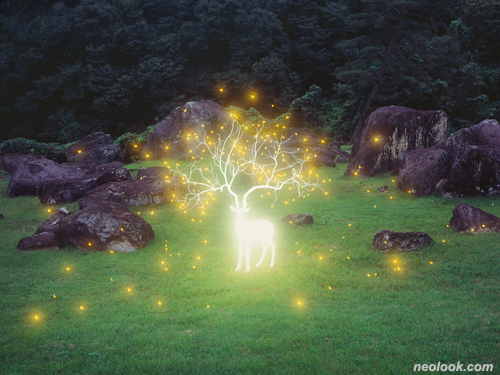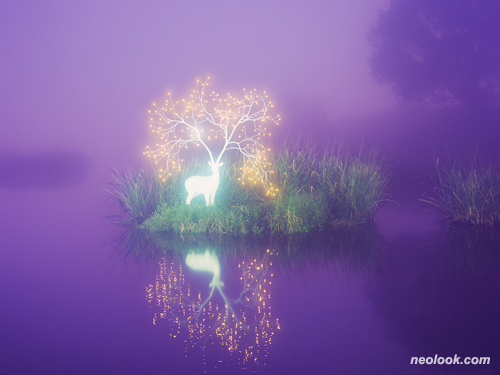- ● homepage
- ● archives
- ● restoration
- ● books
- ● big banners
- ● post board
- ■ neo's search
- ■ about us
- ■ 게재방법 안내
- 개인정보처리방침

- [email protected]
- Tel. 02_335_7922
- Fax. 02_335_7929
- 10:00am~04:30pm
- 월요일~금요일
- 3/3(월) 대체공휴일

White Deer, LUCA
이정록展 / LEEJEONGLOK / 李政錄 / photography 2023_0525 ▶ 2023_0725 / 일,월요일 휴관
● 위 이미지를 클릭하면 네오룩 아카이브 Vol.20210309i | 이정록展으로 갑니다.
초대일시 / 2023_0525_목요일_03:00pm
관람시간 / 11:00am~06:30pm 토요일_12:00pm~05:00pm / 일,월요일 휴관
소울아트스페이스 SOUL ART SPACE 부산 해운대구 해운대해변로 30 Tel. +82.(0)51.731.5878 www.soulartspace.com blog.naver.com/soulartspace www.facebook.com/soulartspace @soulartspace
이정록은 2007년에 '신화적 풍경'이라는 제목의 개인전을 연 바 있다. 그런데 이 명명은 사실상 그의 작품 세계 전체에 적용해도 무방하다. 우리가 '신화적'이라는 표현에서 떠올리는 오래된 시간, 초자연적인 현상, 신비로운 분위기, 그리고 이야기적 요소 같은 것들은 그의 작품 세계 전체를 관통하는 정서이기도 하다. 이정록은 20년이 훌쩍 넘는 시간 동안 하나의 주제에 천착해 왔으며, 그것은 그가 여러 매체를 통해 밝힌 바에 따르면 경험적 세계 너머에 있는 어떤 근원적인 것 – 신성, 우주의 질서, 혹은 생명의 근원일 수도 있는 어떤 에너지를 표현해내는 것으로 이해된다. 이 하나의 주제는 대체로 자연 풍경이나 나무, 나비와 같은 대상에 빛이라는 장치를 가미하여 변주되어왔다.

- 이정록_LUCA L 2-2_C 프린트_90×120cm_2022
빛은 이정록 작가의 작업에서 무엇보다 중요한 요소 중 하나이다. 1990년대 후반에 흑백 은염으로 제작한 「사적인 빛」 연작에서 그는 “라이트 페인팅 기법을 통해 비물질적인 빛을 물질적인 오브제로 전이시키는 방법을 발견했다“고 언급한 바 있으며, 제목을 통해 빛이 단순히 형식적 기법을 넘어서 작업의 주제를 드러내는 핵심적 요소임을 암시했다. 카메라 플래시의 순간광의 중첩을 본격화한 「생명나무」(2009-)를 거쳐 빛에 구체적인 형상을 부여한 「나비」(2015)에 이르면 빛은 단순한 기법을 넘어 작품의 중심 소재로 기능하기에 이른다. 이러한 경향은 아이슬란드의 독특한 자연 풍광과 산티아고의 순례길을 배경으로 제작한 「아이슬란드」(2019)와 「산티아고」(2019) 연작으로도 이어진다. 특히 「아이슬란드」와 「산티아고」에서는 산등성이와 들판, 계곡과 호수, 나무와 숲, 돌무덤과 길, 오래된 건축물 위로 원이나 나비 등의 형상을 한 빛이 흐르는 듯 표현되어 있어, 작가가 표현하고 싶어하는 생명력의 상징으로서의 빛이 어떤 공간을 통과하는 거대한 흐름, 즉 시간이라는 요소와 관련되어 있음을 시사했다. 그런데 이번 전시에서 소개되는 「루카」(2020~2023) 연작이 빛을 이용하는 방식은 근작인 「아이슬란드」나 「산티아고」보다는 2009년에 발표한 「생명나무」에 더 가까워 보인다. 무엇보다도 인공빛을 활용하여 만들어 낸 사슴 형상을 화면 중앙에 배치하고 어슴프레한 자연광의 배경과 대비시킨, 초상과 풍경을 결합한 듯한 구도가 그러하다. 이러한 구도는 어떤 영원불멸한 존재를 연상시킨다는 점에서, 빛을 금방이라도 사라질 듯한 어떤 시간의 흐름처럼 보여준 전작들과는 분명히 궤를 달리한다. 이는 물론 작품의 배경, 즉 촬영 장소라는 맥락과도 관련이 있다. 짐작컨대 「아이슬란드」와 「산티아고」에서는 장소 자체가 지니는 시각적 아우라가 압도적이라 작가적 개입을 최소화하고, 이미 그 자체로 많은 드라마와 오랜 시간을 머금고 있는 자연 풍경 자체의 경이로움을 드러내는 데 주력했을 것이다.

- 이정록_LUCA L 6-1_C 프린트_120×160cm_2022
그런데 「루카」는 얼핏 형식적으로 비슷해 보이는 「생명나무」와도 근본적인 차이가 있다. 사실 작가가 생명의 근원적 에너지에 대한 탐색의 과정에서 나무라는 소재에 주목한 것은 우연이 아니다. 나무는 거의 모든 문화권의 종교와 신화에 중요한 소재로 등장하며 오랫동안 경외와 숭배의 대상이 되어왔다. 이는 인류가 오랜 시간 동안 나무가 매해 잎을 피웠다가 떨구기를 반복하며, 인간보다 더 크게 자라나고 더 오래 사는 모습을 지켜보면서 나무를 성장과 죽음, 부활의 강력한 상징으로 보게 되었기 때문이다. 그만큼 나무는 보편성을 지닌 상징물이다. 그런데 나무와는 달리, 흰 사슴은 현실 세계에는 존재하지 않는다. 작가는 제주도에서 촬영을 하던 중에 백록담이라는 이름이 흰 사슴이 노니는 곳에서 이름이 유래했다는 전설을 들은 후 흰 사슴의 이미지를 작업에 사용하기 시작했다. 제목의 루카(LUCA)는 모든 생물의 공통 조상(last universal common ancestor)을 의미하는 단어에서 따왔다고 한다. 작가는 사슴 조형물을 만들고 스튜디오에서 형식실험을 거친 후 야외로 무대를 옮기는 시행착오의 과정을 거쳐 이 시리즈를 만들어냈으며, 이 작업을 통해 한층 더 신화에 다가간다. ● 한편 「생명나무」의 배경이 장소와 시간을 특정하기 어려운 모호함을 통해 신비로운 분위기를 자아냈다면, 「루카」의 배경은 완만한 산등성이와 대나무 숲, 노란 유채꽃밭 등 우리에게 어느 정도 익숙한 풍경을 담고 있어 대조를 이룬다. 전남 화순 등 작가의 거주지에서 비교적 근거리에 위치한 이 작품의 배경은 계절감도 비교적 생생히 드러냄으로써, 우리가 살고 있는 현실의 풍경에 조금 더 가까이 닿아 있다. 흰 사슴이라는 전설 속 존재를 조형물로 만들어 사진에 등장시키는 꽤나 과감한 선택을 하면서, 작가는 자칫 이 이미지가 우리가 발 딛고 있는 땅과는 영 무관한, 판타지아의 영역으로 넘어가 버리는 것을 경계했던 것은 아닌지, 그래서 오히려 좀 더 친숙하고 현실적인 풍경을 배경으로 선택한 것은 아닌지, 짐작해 볼 수 있다.

- 이정록_LUCA L 8-1_C 프린트_90×120cm_2022
디지털 카메라와 포토샵을 이용하면 얼마든지 더 신비롭고 아름다운 이미지, 더 '신화적인' 풍경을 만들 수 있다는 사실은 자명하다. 그런데 실제로 이정록의 작품 제작 과정에는 적절한 장소를 찾아 헤매고, 각종 조형물을 제작하고 촬영 장비를 갖추어 설치하고, 하루 중 자연광이 미묘하게 변화하는 순간을 포착하기 위해 적당한 타이밍을 노리며 하염없이 대기하는 등, 온갖 수공예적이고 수고스러운 노동이 동원된다. 어쨌거나 한 장의 이미지라는 결과물로 평가받는 시각예술에서 이 과정은 과연 어떤 의미를 지니는가, 라고 누군가 묻는다면 예술 수용의 입장에서는 개개인의 감상자가 판단할 몫이라고 밖에 답할 도리가 없을 듯하다. 그러나 적어도 작가는 애초에 답할 수 없는 하나의 거대한 질문을 일생의 과제처럼 떠안고, 끊임없이 손으로 무언가를 만들고 직접 몸을 움직이는 지난한 노동의 과정을 겪어내며, 미련하게 이미지를 만들어나가는 과정 속에서 어느 순간 스스로 그 의미를 만들어 내고 있는 것으로 보인다. ■ 이사빈

- 이정록_LUCA L 15-1_C 프린트_120×160cm_2023
Jeonglok Lee held a solo exhibition titled "Mythical Landscape" in 2007, and this title can be applied to his entire artistic world. The emotional atmosphere that we associate with the term "mythical" - old times, supernatural phenomena, mysterious atmosphere, and storytelling elements - permeates his entire artistic world. Lee has been fixated on one theme for over 20 years, which, according to his own statements, involves expressing some fundamental energy beyond the experiential world - such as the divine, the order of the universe, or the origin of life - through various media. This one theme has been varied through the use of light as a device applied to natural landscapes, trees, butterflies, and other subjects. ● Light is one of the most critical elements in Lee's work. In the series "Personal Light," created using black and white lithography in the late 1990s, Lee mentioned that he discovered a method of transforming immaterial light into material objects using the "light painting" technique. The title itself suggests that light is a crucial element that reveals the subject matter of the work beyond just a formal technique. In 「Tree of Life」(2009-) where he thoroughly developed the overlapping of momentary flashes of light from camera flashes, and in 「Butterfly」(2015), where light takes on a specific form, light functions as a central subject matter beyond just a simple technique. This trend continues in the series 「Iceland」(2019) and 「Santiago」(2019), created against the backdrop of the unique natural landscapes of Iceland and the pilgrimage route in Santiago. In particular, light, which takes on the shape of circles or butterflies flowing over mountains, fields, valleys, lakes, trees, forests, and old buildings, symbolizes the vitality of life and suggests a connection to the element of time as a massive flow that passes through a certain space. However, the way Lee uses light in his latest series, 「LUCA」(2020-2023), is closer to 「Tree of Life」 than to 「Iceland」 or 「Santiago」. Above all, the composition of the deer-shaped object created using artificial light and juxtaposed with the background of natural light is reminiscent of a combination of portraiture and landscape painting, similar to that of 「Tree of Life」. This composition evokes an eternal and immortal existence, which is different from the previous works, which give the impression of light flowing through time that can easily disappear. Of course, the context of the background of the work, i.e., the shooting location, is related to this. It can be assumed that in 「Iceland」 and 「Santiago」, Lee focused on revealing the wonder of the natural landscape itself, which is already full of drama and has been imbued with time, rather than minimizing artistic intervention due to the overwhelming visual aura of the location. ● However, there is a fundamental difference between 「LUCA」 and 「Tree of Life」, which Lee focused on as part of his exploration of fundamental energy. Unlike trees, which have been an important subject in the mythology and religion of almost all cultures and have been an object of awe and worship for a long time due to their annual cycle of leafing and falling, growing larger and living longer than humans, deer do not exist in the real world. While shooting on Jeju Island, Lee heard about the legend that the name "Baekrokdam" was derived from the place where a white deer wandered, and began to use the image of a white deer in his work. The title 「LUCA」 is derived from the word that means the last universal common ancestor of all living things. By making a sculpture of a deer and going through a process of experimentation with the form in the studio and then moving the stage outdoors, Lee approaches the realm of myth even further. ● On the other hand, while the background of 「Tree of Life」 created a mystical atmosphere through its ambiguity in specifying the location and time, the background of 「LUCA」 portrays landscapes that are relatively familiar to us, such as gentle mountain ranges, bamboo forests, and yellow rapeseed fields, creating a contrast. The setting of this work, which is located relatively close to the author's residence in Hwasun, Jeollanam-do, vividly portrays the seasonal changes, bringing us closer to the landscapes of our reality. While it was a bold choice to create a sculpture of the legendary white deer and include it in the photographs, the author may have been wary of this image being perceived as disconnected from the land we walk on, and instead chose a more familiar and realistic background. This is a possibility we can infer. ● While digital cameras and Photoshop can create more mystical and beautiful images or landscapes, in Lee's work, the process involves searching for an appropriate location, creating various sculptures, setting up photographic equipment, and patiently waiting for the perfect moment to capture the subtle changes in natural light. In terms of artistic reception, it is up to individual viewers to determine the meaning behind this process and the final images. However, it is clear that Lee has pursued an unanswerable question as a lifelong task and has created his own meaning through the process of making images by hand and moving his body relentlessly. ■ Lee Sabine
Vol.20230525c | 이정록展 / LEEJEONGLOK / 李政錄 / photography

